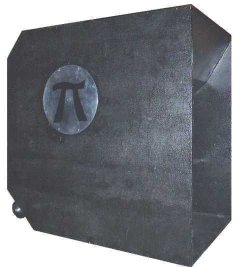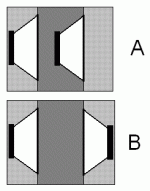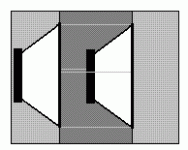I've had very good success with my 12Pi push-pull hornsub. The push-pull drive cancels second harmonics and the low-pass filter formed by the front chamber and folds attenuates third harmonics. Fourth harmonics are canceled by push-pull drive and further reduced by the low-pass features. Everything above that is too far out of band.

- Push-pull benefits quantified (measurements)

I've just re-read my own posts in this thread and have realised that I didn't really make my own idea very clear. The very badly drawn illustrations I posted in posts #1, #18 and #27 are supposed to be toruses (or is that torii?). Just like the (much better illustrated) one in Dave posted in post #10 (except for the isobaric bit). Although I now realise they could have been mistaken for small enclosures with big woofers stuck on each end...
So, the push/pull discussion may or may not apply in the same fashion. Workhorse's posts (2-4) is a closer approximation to what I'm looking at, except that his woofer are in 2 separated enclosures. Whereas I was intending for the whole torus to be one single enclosure.
So, the push/pull discussion may or may not apply in the same fashion. Workhorse's posts (2-4) is a closer approximation to what I'm looking at, except that his woofer are in 2 separated enclosures. Whereas I was intending for the whole torus to be one single enclosure.
Cloth Ears said:I've just re-read my own posts in this thread and have realised that I didn't really make my own idea very clear. The very badly drawn illustrations I posted in posts #1, #18 and #27 are supposed to be toruses (or is that torii?). Just like the (much better illustrated) one in Dave posted in post #10 (except for the isobaric bit). Although I now realise they could have been mistaken for small enclosures with big woofers stuck on each end...
So, the push/pull discussion may or may not apply in the same fashion. Workhorse's posts (2-4) is a closer approximation to what I'm looking at, except that his woofer are in 2 separated enclosures. Whereas I was intending for the whole torus to be one single enclosure.
Make your enclosure like #1 in your post #27. Do not waste your time with #2 or #3.
Rgs, JLH
Workhorse's posts (2-4) is a closer approximation to what I'm looking at, except that his woofer are in 2 separated enclosures. Whereas I was intending for the whole torus to be one single enclosure.
Goodluck CE.....!!
JLH said:Make your enclosure like #1 in your post #27. Do not waste your time with #2 or #3.
Rgs, JLH
JLH,
I understand your intent. Is the only thing required, for this cancellation of even order distortion, that the 2 drivers be wired out-of-phase?
In other papers (JK's on Isobaric) the designs all show the woofers to move in the some direction at the same time.
If I set up my 'torus' as in my post in #1, but make them 2 enclosures and wire them out-of-phase, would this also have the same cancellation effect?
Push-pull drive has both drivers in-phase acoustically, so there is increased voltage sensitivity just like a standard parallel connection of two drivers. The difference is the distortion caused by asymmetry from magnet and suspension non-linearity is cancelled. That's the benefit of push-pull drive.
Cloth Ears said:
Is the only thing required, for this cancellation of even order distortion, that the 2 drivers be wired out-of-phase?
No, what is required to cancel even order distortion is for the two drivers to be moving in opposite phase relative to their suspensions. In other words, the cone of one driver moves away from it's magnet, while the other moves towards it. BUT, once you install drivers this way, you then need to wire them out of phase to ensure that they are acoustically IN phase (both moving in to the box, and out of the box, in unison). In other words, wiring them out of phase is not what cancels the distortion, but rather a consequence of arranging the drivers in such a way that cancels distortion.
If I set up my 'torus' as in my post in #1, but make them 2 enclosures and wire them out-of-phase, would this also have the same cancellation effect?
I'm not sure I follow your torus arrangement correctly, but to answer the question generally: two drivers mounted as push-pull do NOT have to be in the same enclosure to reap the distortion cancellation benefits. The distortion is cancelled due to non-linearities of the suspension and possibly even motor effectiveness... the motion may not represent a perfect sine wave: the cones movement away from the magnet may not perfectly mirror the movement towards it. Using two drivers such that one is away from the magnet while the other is near it causes these differences to be averaged out, so the NET movement between the two becomes the same for each half of the sine wave.
Essentially, there are a few things to consider:
1) Reverse mounting of half of your drivers helps to cancel even order distortion. Doing such requires wiring the reverse mounted drivers out of phase to maintain in phase operation mechanically.
2) Mounting drivers on opposite sides of the box such that the cones are moving in opposite direction relative to one another causes the vibrations they transmit to the box to cancel out. This, in itself, will not directly affect even order distortion, but you can combine opposite end mounting with reverse mounting to reap both benefits.
3) Operationally, it does not matter if the drivers share an enclosure or not. It only matters if one amp or driver fails (causing it to become a poorly tuned passive radiator for any drivers it shares an enclosure space with). With separate enclosure spaces, one driver can continue to operate under proper parameters all on its own.
4) The drivers don't HAVE to share a cabinet. Putting them in separate cabinets gives you freedom to move them around, possibly finding locations that gives more even room response due to interactions and cancellations of room nodes. But moving the drivers apart will reduce the gain reaped due to co-location. It is generally considered that drivers need to be within 1/4 wavelength to reap co-location gain benefits. Two subs spaced apart may give you 3db gain over one sub, while two subs co-located may give you 6db gain. Obviously, two drivers in two separate enclosures prevents the box vibration benefits described in #2, but you could still have two separate drivers in two separate boxes, but one reverse mounted to reap second order distortion cancellation described in #1.
dscline said:2) Mounting drivers on opposite sides of the box such that the cones are moving in opposite direction relative to one another causes the vibrations they transmit to the box to cancel out.
To maximize this benefit the drivers need to be physically coupled quite tightly. The box alone is not sufficient.
dave
Parham! Thanks a lot for your info. if i have a free time i'll read it . sorry i never heard the sound when cancels second harmonics distortion.
regards
 /TW
/TW
_________________________________________
Please do it while u drink.if don't drink please don't do it.
To be explode because u do. Please u say who can do?
regards
_________________________________________
Please do it while u drink.if don't drink please don't do it.
To be explode because u do. Please u say who can do?
Have been reading this thread with interest. With regard to a W frame dipole subwoofer (similar to ripole but wider opening) I should use an arrangement like pictured in "A" to gain a distortion cancelling advantage? Potential drawback being more audible pole piece noise (likely quite significant drawback). At the moment I have the arrangement as per B, worth turning it round?
Attachments
dscline said:No, what is required to cancel even order distortion is for the two drivers to be moving in opposite phase relative to their suspensions.
...
2) Mounting drivers on opposite sides of the box such that the cones are moving in opposite direction relative to one another causes the vibrations they transmit to the box to cancel out. This, in itself, will not directly affect even order distortion, but you can combine opposite end mounting with reverse mounting to reap both benefits.
...
Thanks, I'm convinced. Nice build site...
planet10 said:
To maximize this benefit the drivers need to be physically coupled quite tightly. The box alone is not sufficient.
dave
Just to be sure, we are talking about the 'vibrations' caused by the recoil force encountered by the cabinet in reaction to the cone acceleration (conducted from the motor through the basket to the cabinet), right?
The idea is making it equal and opposite so the net acceleration of the baffle is 0 (making it not behave like a dipole), but if these bl/suspension irregularities are significant, they'll manifest as it not quite cancelling, though it is small and the amplitide will likely be tiny, and it's better than having the spl distorted directly by the irregularities.
Blah blah free lunches. This lunch is cheap.
In my W frame example better driver coupling could be achieved through threaded rods passing through the basket mounting points; diagram attached 
I tried turning one driver round so it is arranged as seen in my attached diagram. Seems to be some improvement actually, low bass notes are clearer sounding. Turned up higher the output sounds quite distorted (boomy?) right up close but when you back away just a foot or two from the opening it cleans right up . Sounds clean at the listening point anyhow, needs more output though or multiple units as is a better solution.
. Sounds clean at the listening point anyhow, needs more output though or multiple units as is a better solution.
I tried turning one driver round so it is arranged as seen in my attached diagram. Seems to be some improvement actually, low bass notes are clearer sounding. Turned up higher the output sounds quite distorted (boomy?) right up close but when you back away just a foot or two from the opening it cleans right up
Attachments
Dr EM,Dr.EM said:In my W frame example better driver coupling could be achieved through threaded rods passing through the basket mounting points; diagram attached
I tried turning one driver round so it is arranged as seen in my attached diagram. Seems to be some improvement actually, low bass notes are clearer sounding. Turned up higher the output sounds quite distorted (boomy?) right up close but when you back away just a foot or two from the opening it cleans right up. Sounds clean at the listening point anyhow, needs more output though or multiple units as is a better solution.
did you also changed the phase of one of the drivers by swapping + & - cable when you swapped the mounting direction?
And taking the idea one step further a concept for a push-pull-push-push isobarik woofer )net volume required is the same as for a single driver -- the torus spape an easy way to hide the magnets.
dave

I know this is an old thread but I'm looking to build something like this, can someone explain to me how this is a push-pull-push-push? isn't it push-pull-pull-push? that would seem to indicate to me that it's in phase-out of phase-in phase-in phase. Wouldn't the 2nd pair just blow out the surrounds?
- Status
- This old topic is closed. If you want to reopen this topic, contact a moderator using the "Report Post" button.
- Home
- Loudspeakers
- Subwoofers
- Opposed drivers

